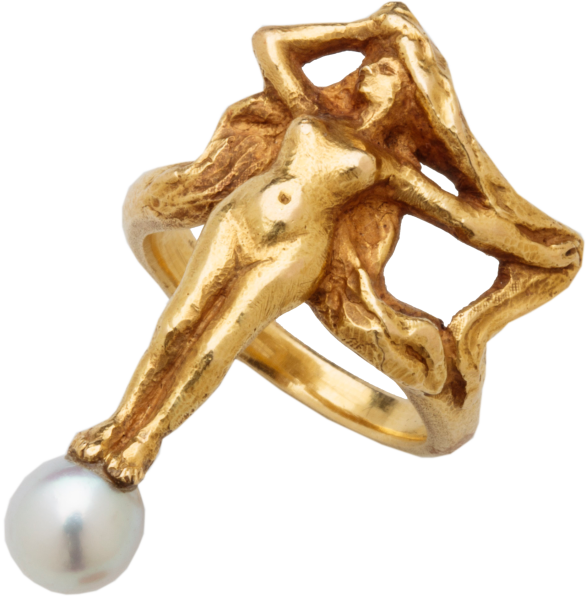


Ring with Euterpe Playing the Flute
, France (Paris), c. 1890Ring with Euterpe Playing the Flute
Description
Gold ring with rounded hoop, profile edging, and the ends formed like a capital with scrolls, foliage and palmette. These support the rectangular bezel with openwork frame, beaded surround and rosettes in the corners. The top and lower edge have a palmette with s-scrolls as ornament. Inside the frame stands the figure of Euterpe wearing a chiton and playing the double flute. On the reverse, at the lower bar of the niche, is the engraved maker’s name WIESE.
Napoléon Bonaparte’s Egyptian campaign, excavations at Nineveh of Ancient Assyria, the founding of the Suez Canal – these events all inspired a renewed interest in antiquity in the nineteenth century. The single most influential event, however, that helped foster a new vocabulary among Paris jewelers was Emperor Napoléon III’s purchase in 1861 of the collection of the Vatican pawnbroker, Marchese Giovanni Pietro Campana. Installed in the Louvre, the Campana Collection comprised early Italian paintings, ancient sculpture, and 1,146 pieces of ancient jewelry. No wonder the 1867 Exposition Universelle sponsored by Napoléon III in Paris featured so prominently newly fashionable “archaeological-style” jewels.
This ring is a classic example of the French taste of archaeological-style jewelry. Posed gracefully and swaying slightly in a niche, the figure represents Euterpe, one of the nine muses of Greek mythology. Wearing a chiton, she plays the double flute, symbolic of her role as the muse of lyric poetry. Stylized palm leaves, or palmettes, decoratively frame the figure on four sides, providing visual anchors for the openwork niche. Characteristic of Paris archaeological-style jewelers, the imagery freely adapts, rather than slavishly copies, its classical source, which was perhaps a vase painting, a stucco plaque, or a statue.
Better known for his interpretations of the Gothic, Louis Wièse also became fascinated by Greek and Roman art. The firm exhibited a range of archaeological-style jewels for the first time in the 1867 World’s Fair, at which it won a bronze medal. The use of the maker’s mark indicates a date around 1890 when Louis registered his new mark after his father’s death.
Literature:
Hellmuth 2014, pp. 232–233, no. 50 (silver Roman-style necklace); Hellmuth 2014, p. 207, no. 36 (Egyptian-style bracelet, dated 1867); Gere/Rudoe 2010, p. 363, fig. 326 (brooch depicting Fortuna, British Museum, Hull Grundy Gift); and exh. cat. Un rêve d’Italie (Roman stucco, p. 260, fig. 60 and terracotta plaque 1st BC/1st AD, Italy p. 60, no. 21).
